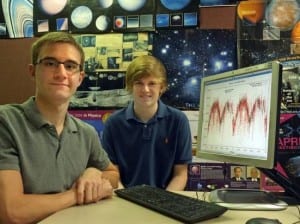Two high school students collected data until they had what they needed to define their star-to-be as a variable — a star that changes brightness.

Reporter Alexis Espinosa with the Dallas Morning News covered the discovery of five stars made by two Dallas high school students as members of an SMU summer physics research program. Called Quarknet, the program enabled the students to analyze data gleaned from a high-powered telescope in the New Mexico desert.
All five stars are eclipsing contact binary stars, pairs of stars that orbit around each other so closely that their outer atmospheres touch. As the stars eclipse, they dim and then brighten as one emerges from behind the other. These stars are categorized as variable stars, stars that change brightness, which make up half the stars in the universe.
Lake Highlands High School seniors Dominik Fritz and Jason Barton are the first high school researchers at SMU to discover new stars.
Fritz and Barton are among nine high school students and two high school physics teachers who conducted physics research at SMU through the QuarkNet program.
EXCERPT:
By Alexis Espinosa
Dallas Morning News
Dominik Fritz sat in a Southern Methodist University science lab sifting through data. He hoped to discover a star by searching through months of information collected from a telescope in the New Mexico desert 14 years ago.
And then he found it.He found a star whose variation had not yet been defined. And he would be the one to define it.
He collected data until he had everything he needed to define it as a variable — a star that changes brightness. A day after he submitted the star to the American Association of Variable Star Observers, the organization requested a few minor corrections.
And then, his star was accepted.
“I was so, so happy. My name is out there. I felt like I really accomplished something,” Fritz said. “I can literally tell people … ‘I found a star.’”
Fritz and a classmate, Jason Barton, both discovered stars this summer as part of the SMU’s QuarkNet program.
QuarkNet is a physics teacher development program funded by the National Science Foundation and the U.S. Department of Energy in universities and laboratories across the country. SMU’s QuarkNet program, which began in 2000, also provides research opportunities to high school students like Fritz and Barton, who are seniors at Lake Highlands High School in Richardson ISD.
